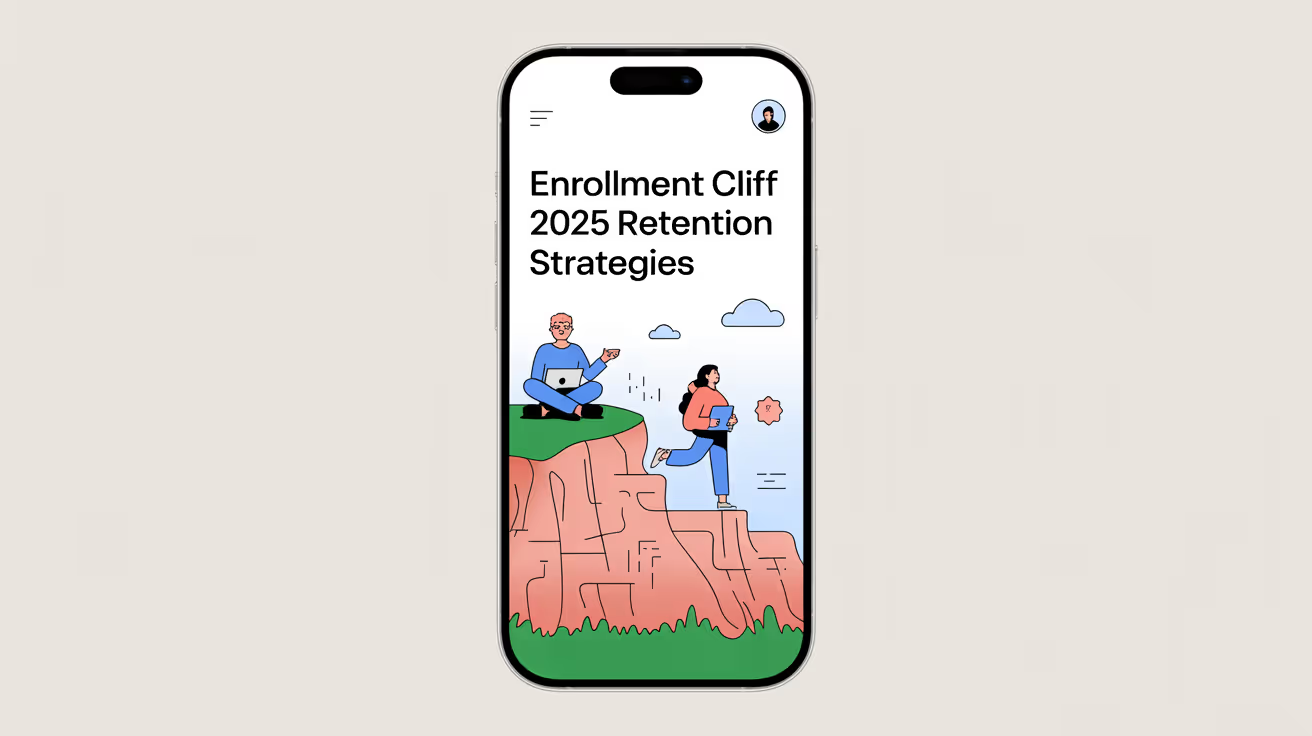Featured Snippet
The 2025 enrollment cliff marks when U.S. high school graduates peak before declining 13% through 2041, according to WICHE projections. Colleges can counter this demographic shift through proven retention strategies: early intervention systems, stop-out recovery programs, and expanded adult learner initiatives that together can improve retention rates by 5-10 percentage points.
The Enrollment Cliff Reality: Understanding the Numbers
The demographic shift facing higher education has arrived. According to the Western Interstate Commission for Higher Education's (WICHE) latest projections, high school graduates will peak in 2025 before entering a sustained decline through 2041.
The numbers tell a stark story. WICHE projects that the total number of high school graduates will peak in 2025 before entering a period of steady decline through 2041 attributable to fewer births 18 years prior. Ultimately, the nation is projected to see a 13% decline from the peak through the end of the projections. This translates to a drop from approximately 3.9 million graduates in 2025 to 3.4 million by 2041.
But the impact won't be uniform. The Midwest and Northeast have already experienced declines in the total number of graduates. The South will continue to defy broader national trends with growth followed by a slight decline at the end of the projections, while the West more closely mirrors national projections. Some states face particularly severe challenges—Pennsylvania and Illinois each project declines exceeding 18%, while states like Florida and Nevada may actually see growth.
The Financial Imperative of Retention
When your incoming student pipeline contracts, retention transforms from important metric to survival strategy. The economics are compelling: industry research consistently shows that recruiting a new student costs approximately five times more than retaining a current one.
Let's examine the math. A typical mid-sized institution enrolling 2,000 first-year students with 70% retention loses 600 students annually. Improving retention by just 5 percentage points keeps 100 additional students enrolled. At an average annual tuition of $15,000, that's $1.5 million in retained revenue per year—$6 million over four years—without spending a dollar more on recruitment.
Yet the value extends beyond immediate revenue. Retained students become alumni donors, send their children to your institution, and serve as brand ambassadors in their communities. They represent compound value that no amount of recruitment spending can replicate.
Evidence-Based Success: Institutions Leading the Way
Georgia State University's Data-Driven Transformation
Georgia State University has become the national model for using predictive analytics to improve retention. Since 2003, the university has increased our six-year graduation rate by 23 percentage points. We graduate more than 10,000 career-ready students each year. We've reduced the average time to earn a degree by almost a full semester, saving students $21 million in tuition each year.
Their comprehensive approach monitors over 800 risk factors for each student in real-time. The institution's systems update student grades and records every night, and they review 800 risk factors for each of the 50,000 students on a continuous basis. When warning signs appear—a missed class, a poor quiz grade, reduced campus engagement—advisors receive immediate alerts and intervene before problems escalate.
The investment has paid dividends. The university hired 42 new advisers in the first six months after launching its data initiative in 2012, at an annual cost of $2.5 million per year. However, Renick said, student retention has increased by 4 percent -- which equates to $10 million a year in tuition payments and fees.
Community College Innovation: The Perimeter College Model
Georgia State's Perimeter College demonstrates that retention strategies work across institutional types. Since consolidation, Perimeter College's three-year graduation rate has improved from 6.5 percent to 15 percent. The gap between the graduation rates of black and white students has been halved, and now white, Latino, and Pell Grant students all graduate at the same rate.
Their Freshman Learning Communities (FLCs) have been particularly effective. Together with the program's Summer Success Academy, Decatur LIFT participants in 2017-18 had a one-year retention rate 20 percentage points higher than non-participants and earned nearly 14 more credit hours over their first 12 months of college than their peers.
Actionable Retention Strategies for Every Institution
1. Implement Proactive Early Alert Systems
Traditional early warning systems fail because they trigger after academic failure becomes evident. Effective systems monitor leading behavioral indicators that predict disengagement weeks before grades drop:
Week 1-2 Indicators:
Class attendance patterns (missing more than one class in first two weeks)
Learning management system login frequency (less than 3x per week)
Meal plan usage changes (20% reduction from baseline)
Library and study space utilization drops
Set automated alerts for these behaviors and mandate advisor outreach within 48 hours. Georgia State's approach generates over 50,000 advisor meetings annually through such triggers.
2. Build Belonging Through Intentional Community
Research from the University of Texas and other institutions demonstrates that belonging interventions can improve retention by 10-15%. Students leave college not because it's too difficult, but because they never feel connected.
Evidence-Based Belonging Builders:
Peer mentorship programs matched by background and major
Learning communities that keep cohorts together for multiple courses
Identity-based success centers (first-generation, transfer, adult learner)
Required small-group academic success teams in large lecture courses
Living-learning communities organized around academic interests
3. Expand Support for Non-Traditional Students
Adult learners accounted for 24% of the undergraduate students who enrolled in the U.S. in fall 2023. These students require fundamentally different support structures than traditional 18-22 year-olds.
Adult Learner Retention Essentials:
Eight-week accelerated course formats
Credit for prior learning assessment (saves average of 9 credit hours)
Evening and weekend advising and support services
On-campus childcare or childcare assistance programs
Stackable credentials that provide value at each completion point
Direct employer partnership pathways
4. Create Stop-Out Recovery Programs
Nearly 30% of students who leave college are stop-outs, not dropouts—they leave temporarily due to life circumstances but intend to return. These students represent low-hanging fruit for enrollment recovery.
Stop-Out Recovery Best Practices:
Identify students who left in good academic standing (2.0+ GPA)
Conduct personalized outreach addressing their specific departure reason
Offer re-enrollment incentives (waived application fees, priority registration)
Assign dedicated "comeback counselors" for returning students
Create cohort programs specifically for returning adults
Implement "fresh start" policies that exclude old grades from GPA calculations
5. Address Financial Barriers Proactively
Financial challenges cause 38% of community college dropouts and 29% at four-year institutions. Yet many students leave without ever seeking financial aid assistance.
Financial Retention Interventions:
Micro-grants for students with small balance holds ($500-$1,500)
Emergency aid funds accessible within 48 hours
Completion grants for students within 15 credits of graduation
Book lending programs or inclusive access textbook models
Food pantries and meal swipe donation programs
Transportation assistance (gas cards, bus passes, emergency repairs)
Setting Measurable Retention Goals Through 2030
Vague improvement aspirations won't counter enrollment declines. Institutions need specific, measurable retention targets with clear accountability.
Year 1-2: Foundation Building (2025-2026)
Target: 2-3% retention improvement
Focus: Quick wins through improved orientation, early alerts, financial micro-grants
Metrics: Weekly tracking of at-risk student interventions, response rates, outcomes
Year 3-4: Scaling Success (2027-2028)
Target: Additional 3-5% retention improvement
Focus: Comprehensive advising redesign, predictive analytics implementation
Metrics: Risk factor identification accuracy, intervention effectiveness rates
Year 5-6: Transformation (2029-2030)
Target: Sustained 8-10% improvement from baseline
Focus: Culture change, stop-out recovery, adult learner programs
Metrics: Year-over-year persistence, completion rates by student segment
Technology as Force Multiplier
Manual retention efforts hit scalability limits quickly. One advisor can meaningfully support perhaps 150 students, but what happens when you need to monitor 5,000 at-risk students?
Modern retention platforms integrate multiple data streams—academic performance, financial status, engagement metrics, wellness indicators—into unified dashboards. They enable:
Automated nudges for low-risk situations
Prioritized human intervention for high-risk students
Predictive modeling to identify problems before they manifest
A/B testing of intervention strategies
ROI tracking on retention investments
The goal isn't replacing human connection but rather ensuring advisors spend time with students who need them most.
Building Institutional Retention Culture
Sustainable retention requires cultural transformation, not just program implementation. Every campus employee—from faculty to facilities staff—impacts student persistence.
Cultural Transformation Elements:
Universal customer service training focused on student success
Retention metrics included in departmental evaluations
Faculty development on inclusive teaching practices
Staff recognition programs for retention contributions
Student feedback loops that drive institutional change
Transparent retention data shared campus-wide
Acting Now: The Competitive Advantage
The enrollment cliff creates a zero-sum game. Students who might have enrolled at your institution will choose competitors who better support their success. Institutions implementing comprehensive retention strategies now will thrive; those waiting will struggle to survive.
Consider the competitive landscape: If your retention rate is 70% while a competitor achieves 80%, they keep 200 more students per 2,000-student cohort. Over four years, that's 800 additional students—the equivalent of recruiting an entire new class without additional marketing spend.
Conclusion: From Crisis to Opportunity
The 2025 enrollment cliff isn't a future threat—it's today's reality requiring immediate action. Yet within this challenge lies opportunity. Institutions that transform their retention practices won't just survive the demographic decline; they'll emerge stronger, more student-centered, and financially sustainable.
Start with one high-impact initiative this semester. Measure results rigorously. Scale what works. Build momentum through visible wins. Most importantly, remember that behind every retention statistic is a student whose life trajectory depends on completing their degree.
The institutions that thrive through the enrollment cliff won't be those that recruit most aggressively, but those that serve students most effectively. The time to transform your retention strategy is now.
Works Cited
Western Interstate Commission for Higher Education (WICHE) — "Knocking at the College Door: Projections of High School Graduates, 11th Edition." https://www.wiche.edu/knocking/. Published: 2024. Accessed: 2025-09-15.
Georgia State University — "Student Success Initiatives." https://success.gsu.edu/. Published: 2024. Accessed: 2025-09-15.
National Center for Education Statistics — "College Enrollment Rates." https://nces.ed.gov/programs/coe/indicator/cpb/college-enrollment-rate. Published: 2024. Accessed: 2025-09-15.
BestColleges — "Adult Learners in College: Facts & Statistics." https://www.bestcolleges.com/research/adult-learners-college-statistics/. Published: 2025. Accessed: 2025-09-15.
Inside Higher Ed — "Georgia State Improves Student Outcomes with Data." https://www.insidehighered.com/digital-learning/article/2017/07/19/georgia-state-improves-student-outcomes-data. Published: 2017. Accessed: 2025-09-15.
Georgia State University News — "Georgia State University Closes Achievement Gaps In Graduation, Retention Rates At Perimeter College." https://news.gsu.edu/2019/02/20/georgia-state-university-closes-achievement-gaps-in-graduation-retention-rates-at-perimeter-college/. Published: 2019. Accessed: 2025-09-15.




